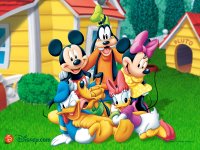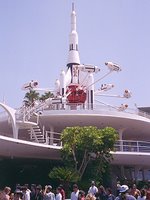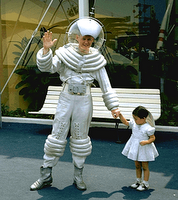
As some are saying, "Disney has fed again" with the death of a 12 year old boy on a roller coaster at the Disney-MGM park. The boy's death is the latest in a string of tragedies at Walt Disney World in recent years. At least 15 people have died at Disney's theme parks in Florida and California since 1989, including some with pre-existing health conditions.
Most have been ruled as Not Disney's Fault, due to pre-existing but unknown medical conditions. It's just been Disney's horrible luck that people keep choosing to drop dead in their parks. Statistically, this isn't that impressive. People get hurt at amusement parks all the time. The CPSC estimates that 57,500 people were treated in hospital emergency rooms for injuries related to amusement park and carnival rides from 1997 to 2004.
Considering Disney's sheer size and the number of visitors it gets, you'd expect far more incidents of death and dispair. But, being Disney, they get big headlines when anything shatters the illusions.
Overall, rides are safe. The perception given by the media, though, is sometimes skewed by how high profile the park may be.
Now, don't get me wrong. I love Disney World. I've been a fan forever, and barring getting assaulted in a men's room by Goofy and Pluto, plan to remain a fan. Sometimes I get a little annoyed when their marketing supercedes their customer satisfaction, like when they have rides unload guests right in the middle of a gift shop aimed at that particular ride. Brilliant marketing, but a pain in the ass if you have two kids, a tired spouse, and ADD. Alon
 g with the other 100 people who suddenly find themselves in a room selling porcelin Buzz Lightyears. I even remember some of their old rides, like Rocket to the Moon, the Skyway, 20,000 Leagues Under the Sea (loved that), Captain EO (probably good they closed that one).
g with the other 100 people who suddenly find themselves in a room selling porcelin Buzz Lightyears. I even remember some of their old rides, like Rocket to the Moon, the Skyway, 20,000 Leagues Under the Sea (loved that), Captain EO (probably good they closed that one).But ol' Walt was an interesting fellow, and his World is just as fascinating (with its share of freakshows, like former Disney Go executive Patrick "Funny Pedophile" Naughton). As I researched Disney, which until now I thought I knew everything about, I ran across parts of the fantasy that were less familiar.
Thought I'd share.
Beginning in the early 1960s, Walt and his lieutenants embarked on a super secret four year project: they traveled the nation in search of a location that gave them access to a major population center, good highways, a steady climate, and, most importantly, cheap and abundant land. Locations were narrowed down, and in the end Orlando, at the crossroads of Florida, was it.
In May 1965, major land transactions were being recorded a few miles southwest of Orlando in Osceola County. Two large tracts totalling $1.5 million were sold, and smaller tracts of flatlands and cattle pastures were purchased by exotic-sounding companies such as the Latin-American Development and Managers Corporation and the Reedy Creek Ranch Corporation. Although the sales reports were open to the public, the identity of the buyers were not.
Months passed and more land changed hands. By late June, the Orlando Sentinel reported that more than 27,000 acres had been sold so far. It wasn't until October when Sentinel reporter Emily Bavar broke the story, was it revealed that Walt Disney was the mastermind behind the purchases.
Forcing his hand, Walt and his brother Roy hastily arranged a press conference and, with the governor by their side, admitted the land was theirs and could only hint at what Disney World would do for Florida. But once Walt described the $400 million project and mentioned the few thousand jobs it would create, Florida's government quickly gave Walt permission to establish the autonomous Reedy Creek Improvement District. With this, he could write his own zoning restrictions and building codes and plan his own roads, bridges, hotels, lakes, horse trails, airport, golf courses, night clubs, theaters, and a residential community for his employees.
Walt played a hands-on role in the planning of Disney World, but just over a year a later, in December 1966, he died. As expected, his faithful brother Roy took control and spent the following five years acting as his brother's executor, supervising the construction of the Magic Kingdom, two resort hotels, and a campground. Fittingly, before the park opened on October 1, 1971, Roy changed the name of his brother's park to "Walt" Disney World so the public would forever recognize who was  responsible for bringing it to life.
responsible for bringing it to life.
Sadly, Roy passed away three months after the park's opening, but by then Walt Disney World was hitting its stride. For the next decade, it became part of Florida's landscape. Families that once saw Orlando merely as a whistlestop on the way to Miami now made their vacation base at Walt Disney World.
One of the more interesting aspects of Disney World, is the RCID (Reedy Creek Improvement District), an actual government entity created by Disney. The district is owned by The Walt Disney Company, a publically-traded corporation."The District is a public corporation of the State of Florida and is located in Orange and Osceola Counties in central Florida, about 15 miles southwest of the City of Orlando. The District currently encompasses approximately 25,000 acres or 38.6 square miles. Approximately 18,800 acres of the District's property are located in Orange County and 6,200 acres are located in Osceola County. Two cities are located within the boundaries of the District, the city of Lake Buena Vista and the city of Bay Lake.
"The District is intersected diagonally (northeast to southwest) by U.S. Interstate Highway Number 4 and midway (east to west) by US Route 192. The land in the District (exclusive of about 2,118 acres primarily owned by the District itself, 450 acres owned by the State of Florida and 24 acres owned by others) is primarily owned by wholly owned subsidiaries of the Walt Disney Company. The District is the site of the Walt Disney World Resort Complex, which was first opened to the public on October 1, 1971.
"The District was created in 1967 when the Florida Legislature passed an act sponsored by delegations from Orange and Osceola counties which created the Reedy Creek Improvement District, combining within one multi-purpose district many of the various powers then found in limited purpose taxing districts in Florida. The act clearly outlines the District's authority to provide essential public services such as drainage and flood control, solid waste collection, wastewater treatment, pest control, fire protection, and the regulation of building codes and land use within the district. It also gives the District authority to issue bonds to finance these improvements and services. The charter also sets forth a number of responsibilities and opportunities for the District, ranging from the promotion of conservation and resources... to the promotion and creation of favorable conditions for the development and practical application of advanced concepts and designs for a recreation oriented community... to the establishment of reclamation, drainage and irrigation of land... to construction and maintenance of essential infrastructure.
As a special taxing district, The Reedy Creek Improvement District must operate in accordance with state laws governing such districts. Just as any city or county, the income is derived from taxes and fees imposed within its boundaries. In the case of the Reedy Creek Improvement District, the major portion of taxes are paid to the District by Walt Disney World Co. and other property owners, who also pay property taxes to Orange and Osceola Counties.
The District is governed by a Board of Supervisors of five members. The Supervisors hold office for staggered terms of four years each. Elections of Supervisors are held every two years at the annual meeting of the landowners of the District, at which two or three Supervisors, as the case may be, are elected.
For Disney, this approach clearly has worked. Total control has enabled Disney to isolate its Magic Kingdom from outside social, political, and intellectual currents. Tourists come from all over the world to enjoy the make-believe worlds that Disney sustains by banishing inconsistent influences.
 The charter legislation for the Reedy Creek Improvement District - bolstered by the promise of EPCOT, but not requiring it - passed the Florida Senate unanimously and the House with one dissenting vote. In 1968 the state Supreme Court confirmed that Reedy Creek could issue tax-free bonds for internal improvements. This power, the court said, would "greatly aid Disney interests" but would carry commensurate benefits to the "numerous inhabitants of the district."
The charter legislation for the Reedy Creek Improvement District - bolstered by the promise of EPCOT, but not requiring it - passed the Florida Senate unanimously and the House with one dissenting vote. In 1968 the state Supreme Court confirmed that Reedy Creek could issue tax-free bonds for internal improvements. This power, the court said, would "greatly aid Disney interests" but would carry commensurate benefits to the "numerous inhabitants of the district."
The inhabitants never came; nary another word was said about building permanent residences on Disney property. EPCOT, planned as an urban utopia, was built in the early 1980s as part world's fair and part corporate showcase, a potent symbol that for Disney, utopian ideals and complete corporate control are intricately intertwined. Today, Disney officials deny having practiced deception with EPCOT, arguing that the residential community was always only one of a number of options.
Not much is made of this episode anymore. And though town-mouse relations have not always been smooth - in 1989, Reedy Creek gobbled up $57 million in tax-free bonds that nearby Orange County had wanted for low-income housing - the company now kicks in for local road improvements and other related expenses, satisfying any lingering skepticism. An editorial in Orlando's major daily paper in 1965, titled "Walt Disney to Wave His Magic Wand Over Us," still resonates today: Disney's illusions draw winks and chuckles; the company pays just enough attention to the way its governmental control looks in order to preserve the way it is.
If anything, Disney officials say, outsiders should be grateful Disney was able to create such an empire without tapping into public resources. "Walt had a dream, and he didn't want local taxpayers to have to pay for it," says Morgan. "In 27 years, not a dime of federal or state tax money has been spent within these 27,000 acres. We've built our own roads and sewers and water plant. And we're the largest taxpayer in Florida ($46 million annually to Orange and Osceola counties) and we ask for essentially no services in return."
Disney is glad to show off its benefits. For several hours one afternoon, Jane Adams, Disney's public relations director, drove me around the property in her Mazda 626, pointing out elements of the massive infrastructure Disney created: the energy facility, the horticultural center, the service areas. I saw greenhouses, wildlife preserves, and the launching pad for the evening fireworks show. Ted McKim, manager of water and waste resources for Reedy Creek Energy Services, explained to me the intricacies of the water and waste treatment. Just what is Reedy Creek Energy Services? "It's a wholly owned subsidiary of Walt Disney World. And we are contracted by the Reedy Creek Improvement District to provide these services." In other words, Disney pays taxes to Reedy Creek, which gives the money straight back to Disney, and the circle is closed.
Such arrangements allow Disney an unparalleled ability to shape the park environment without government oversight. As Rollins College professor Richard Foglesong writes in the Washington Post:
It's legal magic. The Reedy Creek government can regulate land use, provide police and fire services, license the manufacture and sale of alcoholic beverages, build roads, lay sewer lines, construct waste-treatment plants, carry out flood projects - even build an airport or nuclear plant, all without local or state approval.
With freedom from regulatory oversight, Disney could shape the land like so much clay. Take those creeks and streams - they're mostly man-made, landscaped to look natural. In fact, just about anything that's wet inside this district was made or altered by man. The 450-acre Bay Lake is pre-Disney, but it was drained, scoured, and filled with clean water. Five million cubic yards of earth were dug to construct the World Showcase Lagoon at EPCOT. Water flow throughout the park is regulated by radio telemetry and electronic sensors via a satellite in stationary orbit over the equator.
As far as tourists are concerned, most of those details are irrelevant. In fact, the area is meticulously designed to eliminate curiosity about backstage labor. Except for access roads in and out, movement is strictly by Disney transportation. Walking among attractions, while not prohibited, is about as appealing as walking the shoulder of a highway. Most of the backstage is carefully concealed; what is visible is usually impossible to reach. And for the rare spots that might draw too-curious guests, Disney uses subtle landscaping: Walk through the grass and you'll likely find yourself in a drainage ditch.
Yet what goes on behind-the-scenes has more to do with the park experience than most patrons realize. The loops of Disney's self-government, where complexities mask the real transaction of power, find eerie parallels inside the parks, where the company manufactures everything from employee emotions to historical legend. The raw materials of the Magic Kingdom are not just earth, concrete, and paint but people and ideas as well.
Consider Disney's management of its employees' demeanor. Not only does Disney have strict rules about how employees look - no jewelry, no long hair for men - but it regulates how they act, too. In The Managed Heart, sociologist Arlie Russell Hochschild introduces the idea of "emotional labor" to describe the work required of many service employees to produce the moods, facial expressions, and body language that their employers require. Donna Lynn Dalton, 30 years old and a full-time character at Disney World, knows this concept all too well. "You do get hit on a daily basis," says Dalton, whose repertoire includes Roger Rabbit, Bert, Ernie, Honkers, Grover, and Oscar. "You obviously try to get away. But you cannot in any way reprimand or retaliate." Wes Robinson, otherwise known as Goofy, Tigger, or the Sheriff of Nottingham, explains it this way. "It would be unbecoming for a Disney character to retaliate no matter what's happened to you - and believe me we get it."
Of course, Disney's charm - the stuff pilgrims tell the folks back home - is the feel of the place, its cleanliness, efficiency, and safety. Undesirables are kept outside the gates and, if they slip through, are monitored by security guards camouflaged as ordinary cast members or as tourists. For many visitors, this controlled community offers a freedom from the fear and distrust they feel outside. In line, a family from Tennessee chat amicably with a young couple from New York or an elderly gentleman from Tallahassee they might not otherwise ever meet: "Line's not too bad," they offer. "Whereabouts you from?"
All around us, meanwhile, is an environment in which the boundaries of the genuine and the illusory are collapsed, defined, and erased all over again. On Huck Finn's island, speakers hidden in fake tree stumps project real recorded bird calls. The Hall of Presidents features a robotic Bill Clinton, speaking a made-up speech with the president's real voice, while a robotic Abraham Lincoln delivers a real address with a fake voice.
Sources:
The American Prospect, Inc. "Hidden Kingdom," The American Prospect, vol. 6 no. 21, March 21, 1995
Fodors magazine (Gary McKechnie, January 24, 2001)


3 comments:
Fascinating post...Thanks.
bk, that's one of the neatest posts i've read in a long time!
I have to ask your attack by goofy and pluto when and where did this happen i too had a unpleasant encounter when pluto and goofy had a REAL fight at liberty tree tavern it happened march 1998 they were pushing each other around this was not a HAPPY time for me grant you I am an adult but this turned my stomach and my cousin who was only five(he was knocked down by goofy) and my son who was 15 was in shock that this could happen at disney we were in the middle of our meal and we were whisked out before we could even finish we have since been back but goofy (who was my idle) and pluto are not the same in our minds just though you might have been one of the others that were there. by the way disney offered no support with dealing with the mishap thanks for listening Alice
Post a Comment